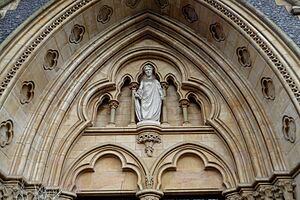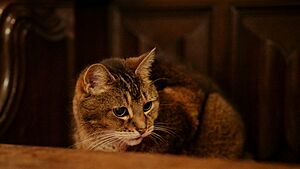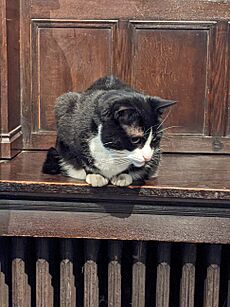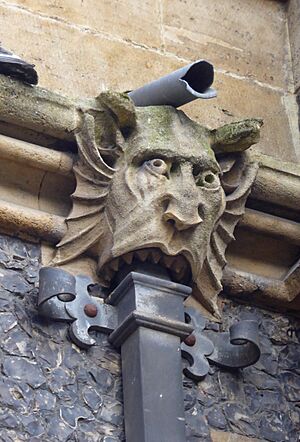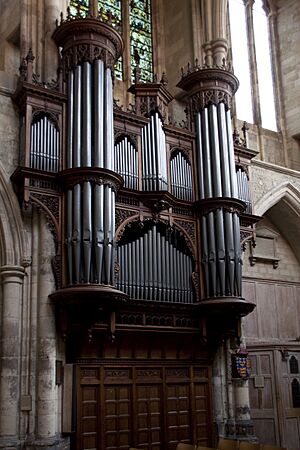Southwark Cathedral facts for kids
Quick facts for kids Southwark Cathedral |
|
|---|---|
| Cathedral and Collegiate Church of St Saviour and St Mary Overie | |
 |
|
| Lua error in Module:Location_map at line 420: attempt to index field 'wikibase' (a nil value). | |
| Location | Southwark London, SE1 |
| Country | England |
| Denomination | Church of England |
| Previous denomination | Roman Catholic |
| Website | cathedral.southwark.anglican.org |
| Architecture | |
| Heritage designation | Grade I listed building |
| Designated | 2 March 1950 |
| Style | Gothic, Gothic Revival |
| Years built | 1106–1897 |
| Administration | |
| Diocese | Southwark (since 1905) |
| Province | Canterbury |
Southwark Cathedral is a historic church in Southwark, London. It is located near the River Thames and London Bridge. This cathedral is the main church for the Diocese of Southwark. People have worshipped here for over 1,000 years. However, it only became a cathedral in 1905.
From 1106 to 1538, it was a church for Augustinian monks, called Southwark Priory. It was named after the Virgin Mary. After the monasteries were closed down, it became a local church. It was then dedicated to the Holy Saviour. The building you see today looks mostly like the Gothic church built between 1220 and 1420. The main part of the church, called the nave, was rebuilt in the late 1800s.
Contents
History of the Cathedral
Early Stories and Beginnings
A historian named John Stow wrote about the church's early days in the 1500s. He heard a story from Bartholomew Linsted, the last leader of the priory. Linsted said the church started as a place for nuns. It was founded by a maiden named Mary, who used money from a ferry business. Later, it became a college for priests. Finally, in 1106, it became a priory for Augustinian monks.
This story about Mary and her ferry was very popular. Some historians later thought the "noble lady" Swithen in the story might have been Swithun, a bishop from the 800s. Some even suggested the nunnery was founded around 606 AD. Today, the cathedral still has a sign saying a convent was founded in 606 AD. However, there is no real proof for these very early dates.
Saxon and Norman Times
The first official mention of the site was in the Domesday Book of 1086. It was called a "minster" (a type of church) and was controlled by William the Conqueror's half-brother.
This old English church served the area south of the River Thames. In 1106, it became an Augustinian priory. The bishops of Winchester supported it. They built their London home, Winchester Palace, nearby in 1149. You can still see a wall from the palace today.
The priory was dedicated to the Virgin Mary as 'St Mary'. It was also called "Overie" (meaning "over the river"). This helped people tell it apart from other St Mary churches in the City of London. Some parts of the church from the 1100s still exist. But the church's current shape comes from the 1200s and 1300s. This makes it London's first Gothic church.
Gothic Style and Rebuilding
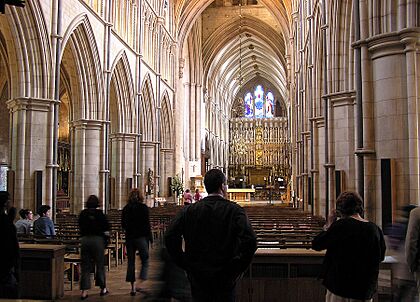
A big fire in 1212 badly damaged the church. It was rebuilt during the 1200s. The new church had a cross shape. It had a main hall (nave), a tower, side sections (transepts), and a choir area. Behind the choir was a smaller area called the retrochoir or Lady chapel.
There was also a chapel for local people. In the 1390s, another fire damaged the church. Around 1420, Henry Beaufort, the Bishop of Winchester, helped rebuild parts of it.
In the 1400s, the local chapel was rebuilt. The nave and north transept got new wooden ceilings. Some carved decorations from the old ceiling are still kept in the cathedral.
The famous poet John Gower lived near the priory in the 1300s. He is buried in the church. His tomb is very grand and still has its original colors. There is also a wooden statue of a knight from the 1200s. It is one of the oldest such memorials.
Changes in the 1500s and 1600s

Around 1520, Bishop Richard Foxe improved the church. He added a stone altar screen and new windows.
Like all other monasteries in England, the priory was closed down by King Henry VIII in 1540. It was then given to the Crown. In that year, St Mary Overie became a new parish church called St Saviour. The local people rented the church until 1614, when they bought it for £800.
During the time of Queen Mary, important trials were held in the retrochoir.
As the local church for the Bankside area, St Saviour's was connected to famous Elizabethan playwrights. William Shakespeare's brother, Edmund, was buried here in 1607. His grave is not marked, but a stone was placed in the choir later. The cathedral holds a festival to remember this history.
There is a large stained glass window dedicated to William Shakespeare. It shows scenes from his plays. Below it is a statue of him holding a quill. Two other playwrights, John Fletcher and Philip Massinger, are also buried in the church.
John Harvard, who helped found Harvard University in America, was born in this area. He was baptized in the church in 1607. The Harvard Chapel in the north transept remembers him. It was paid for by Harvard University graduates living in England.
The connection with the bishops of Winchester continued. Lancelot Andrewes, a bishop who helped write the Authorized Version of the Bible, was buried here in 1626. His tomb was moved behind the main altar later.
In 1647, the artist Wenceslas Hollar drew his famous Long View of London from Bankside from the church tower. This drawing shows what London looked like in the 1600s.
The 1800s and Rebuilding
By the early 1800s, the church building was in poor condition. All the old medieval furniture was gone. Between 1818 and 1830, the tower and choir were repaired by George Gwilt Jun. He tried to make the church look like it did in the 1200s.
In 1831, the roof of the nave became unsafe and was removed. Services were then held in other parts of the church. In 1839, the roofless nave was pulled down and rebuilt. The new nave was at a higher level and separated from the old part. Many people criticized this new design.
So, between 1890 and 1897, the nave was rebuilt again by Arthur Blomfield. He tried to make it look exactly like the original 13th-century design.
A railway viaduct, which connects London Bridge to other stations, passes very close to the cathedral. This was a compromise made in 1852. The other option was to completely demolish the church for the railway line.
The churchyard stopped being used for burials in 1853. In 1910, the garden in the south-west corner was renovated. This garden was restored again in 2001.
Since 1900
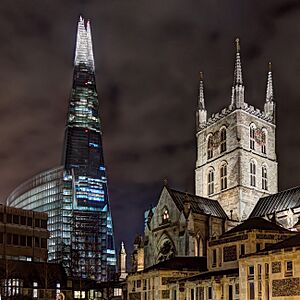
The church of St Saviour became a cathedral in 1905. This happened when the Church of England Diocese of Southwark was created.
The cathedral is in an area that was heavily damaged by German bombing during World War II. Many bombs fell on Southwark. On February 20, 1941, it was reported that the cathedral had been damaged by a bomb. You can still see shrapnel marks on the outside of the building today.
There are memorials inside the cathedral. In 2001, Nelson Mandela opened a new northern "cloister." This area includes a dining hall, shop, conference center, education center, and museum. These new buildings won an award in 2002.
Other Information
The cathedral is used by several universities for their graduation ceremonies. It also hosts the London Nautical School's annual Christmas Carol Service.
There are two other cathedrals in Southwark: the Roman Catholic St George's Cathedral Southwark and the Greek Orthodox St Mary's.
The Great Altar-Screen
Between 1520 and 1528, Bishop Richard Fox built a beautiful stone altar screen. It has two small doors leading to the retrochoir. It is about 30 feet high. Most of the details, like the statues and gold parts, were added in the 1800s and early 1900s.
In 1703, the screen was changed to make it flat for a wooden altar piece. The old Gothic carvings were cut away.
After the wooden altar piece was removed in 1830, the stone screen was fully restored. Most of the new details were carefully copied from the original parts. Some original medieval carvings still exist. These include small images of the Lamb of God and a pelican. There are also funny carvings of hunting scenes, including a man chasing a fox, which was a joke about Bishop Fox's name. Most of the statues in the niches were carved from 1905 onwards. They show important people from the church's history.
Resident Cats
Southwark Cathedral is famous for having a resident cat. The first one was named Doorkins Magnificat. She was a stray cat who started visiting in 2008 looking for food and shelter. She soon made the cathedral her home. Doorkins became a local celebrity. She even met the Mayor of London and Queen Elizabeth II. A children's book, Doorkins the Cathedral Cat, was written about her. In 2018, a stone gargoyle of her was placed inside the cathedral. Doorkins retired in October 2019 and passed away on October 2, 2020. A memorial service was held for her, which was very unusual for a cat.
The cathedral decided to get a new cat in 2020. Hodge, a black and white cat, was adopted from a rescue group on the same day Doorkins died. Like Doorkins, Hodge has become very popular. You can find souvenirs of him in the cathedral shop, and he has his own social media accounts.
Cathedral Choirs
Main Cathedral Choir
The Cathedral Choir gets financial support from a foundation linked to two old local schools. The boys and girls in the choir come from schools all over London. Girls usually join between ages ten and eleven, and boys between seven and ten. The choir also has adult singers and scholars.
The Cathedral Choir performed the music for the television series Mr. Bean.
Some famous former choristers include David Gedge, who became an organist, and Richard Marlow, who directed a choir at Cambridge University. Chuka Umunna, a former Member of Parliament, was also a chorister here.
Merbecke Choir
In 2004, the Southwark Cathedral Merbecke Choir was started. It is for young singers who want to keep their singing skills sharp. They explore many different types of music.
The choir sings a special evening service called Compline once a month. They also perform concerts each term. They have sung for other organizations and even for the Queen's Christmas Broadcast in 2006.
The choir is named after John Merbecke, a composer from the 1500s. He wrote a very popular musical setting for the church's communion service.
Thursday Singers
The Thursday Singers are a choir made up of people from the local community. You don't need to audition to join. They sing for special services during the week. They also lead the singing at the cathedral's Carol Sing-In before Christmas.
Organ
The cathedral's main organ was built by Lewis & Co. in 1897. It was designed to have a bright, lively sound. The organ's main case was designed by Arthur Blomfield.
The organ was mostly unchanged until 1952, when it was rebuilt. However, some of these changes were later thought to take away from the original sound. So, in 1991, the organ was restored to its original Lewis design.
Former organists of Southwark Cathedral include Starling Goodwin and E. T. Cook, who was known for his BBC radio broadcasts.
|
|
|
|
|
||||||||||||||||||||||||||||||||||||||||||||||||||||||||||||||||||||||||||||||||||||||||||||||||||||||||||||||||||||||||||||||||||||||||||||
Images for kids
See also
 In Spanish: Catedral de Southwark para niños
In Spanish: Catedral de Southwark para niños
- St Paul's Cathedral – the Anglican cathedral in the neighboring Diocese of London
- St George's Cathedral, Southwark – the Roman Catholic cathedral in the Archdiocese of Southwark
General:


